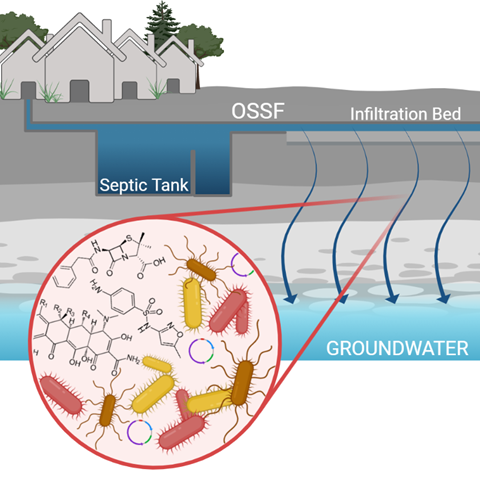Contact
Department of Aquatic Sciences and Assessment, Division of Environmental Organic Chemistry and Ecotoxicology
Department of Aquatic Sciences and Assessment, Division of Environmental Organic Chemistry and Ecotoxicology

This Formas-funded project, STOP-ARG, aims to evaluate and reduce the dissemination of antibiotic resistance from on-site sewage facilities (OSSFs) to the groundwater. The respective potential impacts on groundwater quality and solutions will be studied as well to limit the spread of antimicrobial resistance.
On-site sewage facilities (OSSFs) are commonly used for the sanitation of household wastewater in rural areas and sub-urbanized small communities, where large-scale and centralized wastewater treatment plants (WWTPs) are not feasible to be setup or reached. In Sweden, about 13% of the households are currently connected to OSSFs rather than to municipal WWTPs. The setting of OSSFs often consists of a septic tank, where organic matters are removed through sedimentation, followed by an infiltration system, in which the OSSF effluent is discharged to and infiltrated through soil layers into the groundwater.
As OSSFs are not being designed for the removal of emerging chemical and microbial contaminants, they may be an important diffuse source of pollution to the environment. Due to the persistent and mobile nature of some of these contaminants, they may pass through the soil infiltration system and contaminate the groundwater resources. In this context, knowledge on antimicrobial contaminants (e.g., antimicrobial drugs, their transformation products, antibiotic resistance genes (ARGs), etc.) is largely lacking.
The study is organized in three Work packages (WPs), each of them will focus on different aspects related to OSSFs and antimicrobial resistance.
This WP aims to select a range of relevant antimicrobial chemicals, including their transformation products, based on their consumption in Swedish clinical settings and their prioritization at the European level. The list will primarily include antibiotics, antifungal and antivirals. An analytical method to detect and quantify antimicrobials concentrations in wastewaters and groundwater, will then be established and validated using LC-MS/MS. Furthermore, a routine extraction procedure for antimicrobials from wastewater and other water matrices will be provided.
Sampling campaigns will be conducted in different seasons and locations, targeting common OSSFs-infiltration systems with large design capacity. Water samples will be collected and analyzed for antimicrobial chemicals using the developed analytical method (WP1), and also for microbial contaminants, i.e., ARGs and mobile genetic elements (MGEs) using high throughput-qPCR. The detected concentrations of these antimicrobial contaminants will be used to study their removal efficiency and attenuation in OSSFs and to evaluate their discharge to groundwater. Occurrence of the antimicrobial chemicals will be compared with predicted no-effect concentration values, provided by EU Watch List and scientific literature, to evaluate their potential impact on groundwater quality.
In the last phase of this project, alternative treatment techniques will be investigated to limit discharges of the antimicrobial contaminants from OSSFs to groundwater. Laboratory-scale column tests will be set up and removal efficiency of antimicrobial contaminants will be measured. Finally, a ranking list of the tested removal technologies will be provided, together with an evaluation of their pro and cons and their potential to be implemented in OSSFs.
In Sweden, 50% of drinking water is derived from groundwater, and it is therefore of vital importance to ensure good groundwater quality. STOP-ARG will provide important insights into antimicrobial contaminants in Swedish groundwater. The project’s goals are in accordance with the National Environmental Quality Objectives set by the Swedish Environmental Protection Agency, specifically for the Objective 4 “Non-toxic environment” and Objective 9 “Good quality groundwater”, and also with the Sustainable Development Goal 6 aiming to “Clean water and sanitation” set by the United Nations.
From the Department of Aquatic Sciences and Assessment: Foon Yin Lai (PI), Valentina Ugolini, Lutz Ahrens, Karin Wiberg
From the Department of Energy and Technology: Björn Vinnerås, Annika Nordin
Formas.